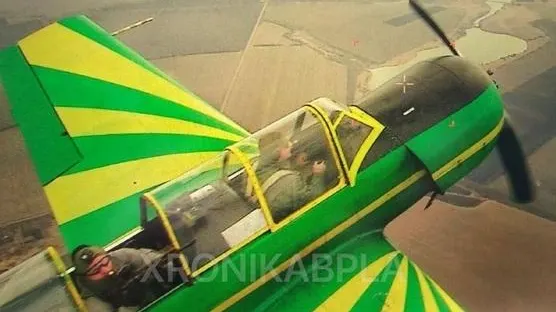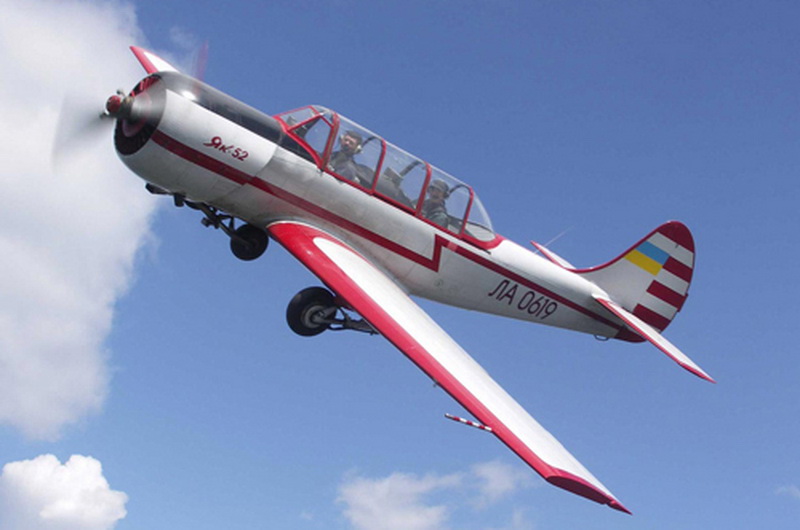The Ukrainians turned at least two propeller-driven Yak-52s into drone-hunters in the simplest way possible: by arming the backseat crew member with a shotgun.
One year later, a Russian design bureau has copied the idea—and added an underwing sensor turret in addition to a backseat shotgun to create the Yak-52B2 variant of the classic training plane.
All the Yak-52 dogfighters, Russian and Ukrainian alike, benefit from availability, simplicity, maneuverability and forgiving low-speed handling at a cruising speed of just 225 km/h. They’re a cheap, effective way of engaging enemy unmanned aerial vehicles (UAVs) over vulnerable cities.
Shooting down a $100,000 Russian drone with an air-defense missile might cost hundreds of thousands or even millions of dollars. Shooting it down with a shotgun from a light plane might cost a few thousand dollars.
“The light-engine Yak-52B2 is capable of hitting both enemy aircraft-type UAVs (for example, An-196 'Liutyi') and light-engine aircraft in the unmanned version (for example, the Aeroprakt A-22),” Military Informant reported.
Measures against Ukraine's long-range drone strikes on Russia?
The threat is real and growing. Ukraine has converted the Aeropract A-22 Foxbat, an ultra-light sports plane, into long-range attack drones capable of hitting targets as far as 1,600 km away.
Over the last year, these included drone production facilities, oil refineries, missile research centers, and naval bases deep inside Russian territory—including Tatarstan, Chechnya, and Dagestan.

Meanwhile, "Liutyi" had been crippling Russian oil refineries and blasting ammunition depots up till 800 km away since early 2024.
Both drones are part of Ukraine's long-range drone program, developed amid a Western ban on striking objects in Russia with missiles. In late 2024-early 2025 alone, these long-range strikes managed to suppress Russia's petroleum products production by 10%, with cascading consequences for military logistics and exports.
Whether Russian forces will adopt the Yak-52B2, and how many copies they might acquire, remains to be seen.
But the need is clear. Russian air defenses are spread thin protecting front-line forces, air bases, oil refineries and cities such as Moscow from Ukraine’s growing inventory of attack drones. “You can’t defend everywhere,” retired US Army Lt. Gen. Mark Hertling noted.
Yak-52 downs Russian drones in WWI-style dogfights
The Ukrainians proved just how efficient a Yak-52 can be in the counter-drone role. In a busy three months starting in May 2024, a Ukrainian Yak-52 shot down a large number of Russian drones over southern Ukraine. The front-seat pilot steered the nimble plane while the gunner in the back opened fire with a shotgun.
One Russian blogger lamented “a Ukrainian with a double-barreled shotgun, firing at our UAVs like it’s a shooting gallery.”
Trending Now
Fans of the Yak-52 crew posted videos and photos of the piston-engine plane in action. A growing number of kill markings on the side of the old trainer spoke to its effectiveness as a drone-killer. It worked so well that the Ukrainian intelligence directorate began training airmen to hunt Russian unmanned aerial vehicles from A-22s, as well.
But that first drone-hunting Yak-52’s fame made it a top target for the Russians. “The Yak-52 flew over Odesa and with high efficiency shot down our reconnaissance UAVs for a week, causing laughter in some circles,” one blogger wrote.
“This has not been funny to UAV operators and us for a long time,” the blogger added. “Isn’t it time to shoot him down?”
It was. On July 15, a Russian drone surveyed Hydroport airfield in Odesa, pinpointing several parked Ukrainian UAVs and hangars where the Yak-52 may have sheltered.
An Iskander ballistic missile streaked in, exploding between the drones and the hangars and sparking several fires. One analyst scrutinized video and satellite imagery and concluded that the Iskander damaged three drones and several hangars. The Yak-52 was apparently damaged or destroyed: there were no more photos or videos of the famous plane.
A list of civilian-registered aircraft in Ukraine from 2014 includes 33 Yak-52s, so it was only a matter of time before Ukrainian forces acquired a replacement airframe. On March 24, a second Ukrainian Yak-52 took to the air over southern Ukraine with a backseat gunner.
That drone-hunter may soon have company on the other side of the 1100-kilometer front line, if and when the Russians deploy their own Yak-52s to defend strategic sites.
Read also
-
Vintage drone-hunting Yak-52 plane returns to Odesa skies
-
Forbes: Ukraine’s canary-yellow vintage Yak-52 is hunting Russian drones like it’s World War I again
-
Forbes: Modified $90,000 sport plane drones give Ukraine 800-mile strike range
-
Meet “Liutyi,” Ukraine’s homegrown drone behind strikes on Russian oil refineries
-
CNN follows Ukraine’s Liutyi drone strike on ammo depot on Russian soil

Technology is Ukraine’s chance to win the war. This is why we’re launching the David vs. Goliath defense blog to support Ukrainian engineers who are creating innovative battlefield solutions and are inviting you to join us on the journey.
Our platform will showcase the Ukrainian defense tech underdogs who are Ukraine’s hope to win in the war against Russia, giving them the much-needed visibility to connect them with crucial expertise, funding, and international support. Together, we can give David the best fighting chance he has.
Join us in building this platform—become a Euromaidan Press Patron. As little as $5 monthly will boost strategic innovations that could succeed where traditional approaches have failed.


